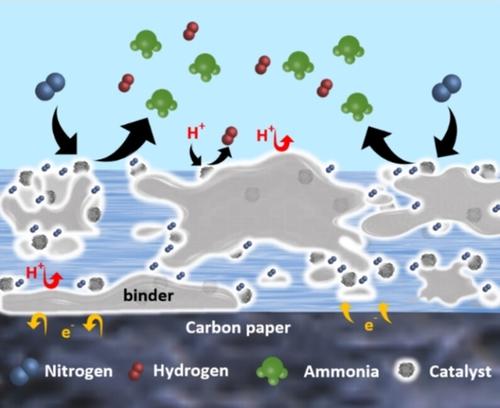当前位置:
X-MOL 学术
›
ChemElectroChem
›
论文详情
Our official English website, www.x-mol.net, welcomes your feedback! (Note: you will need to create a separate account there.)
Efficient N2 Electrofixation to NH3 Through Optimizing Binder‐Catalyst Configuration
ChemElectroChem ( IF 4 ) Pub Date : 2024-03-07 , DOI: 10.1002/celc.202400033 Amirhamzeh Aslambakhsh 1 , Sandra E. Kentish 1 , Colin A. Scholes 1
ChemElectroChem ( IF 4 ) Pub Date : 2024-03-07 , DOI: 10.1002/celc.202400033 Amirhamzeh Aslambakhsh 1 , Sandra E. Kentish 1 , Colin A. Scholes 1
Affiliation

|
Nitrogen electrofixation under ambient conditions is a promising approach to synthesize ammonia sustainably but improving the yield and efficiency remains a challenge. This is due to the competition between the nitrogen electrofixation and hydrogen evolution reactions, which can be depressed through appropriate working electrode design. This study investigated the influence of the catalyst‐binder configuration on ammonia yield and Faradic efficiency. A series of working electrodes were tested in an aqueous system, with the proton and electron transfer on the working electrode found to be dependent on the catalyst material, binder material, and binder hydrophobicity. The use of a binder with low proton/electron conductivity increased Faradic efficiency by hindering the hydrogen evolution reaction and reducing charge transfer to the catalytic material. Utilising a hydrophobic binder significantly improved ammonia yield. Furthermore, nitrogen sorption experiments revealed that the catalyst‘s nitrogen affinity exerts a greater influence on ammonia yield than the binder‘s affinity. The best performance was observed for a semi‐conductive catalyst based on vanadium, integrated within a highly hydrophobic perfluorinated binder. At ambient conditions in 0.1 M hydrogen chloride, 39.3±4.3
中文翻译:

通过优化粘合剂-催化剂配置,有效将 N2 电固定为 NH3
环境条件下的氮电固定是一种有前途的可持续合成氨的方法,但提高产量和效率仍然是一个挑战。这是由于氮电固定和析氢反应之间的竞争,可以通过适当的工作电极设计来抑制这种竞争。本研究研究了催化剂-粘合剂配置对氨产率和法拉第效率的影响。在水性系统中测试了一系列工作电极,发现工作电极上的质子和电子转移取决于催化剂材料、粘合剂材料和粘合剂疏水性。使用具有低质子/电子电导率的粘合剂通过阻碍析氢反应并减少向催化材料的电荷转移来提高法拉第效率。使用疏水性粘合剂显着提高了氨产量。此外,氮吸附实验表明,催化剂的氮亲和力对氨产率的影响比粘合剂的亲和力更大。观察到集成在高度疏水性全氟化粘合剂中的基于钒的半导体催化剂具有最佳性能。在环境条件下,0.1 M 氯化氢中,39.3±4.3与可逆氢电极相比,在 -0.2 V 下合成的氨的法拉第效率为 38.5±4.5 %。
更新日期:2024-03-07
中文翻译:

通过优化粘合剂-催化剂配置,有效将 N2 电固定为 NH3
环境条件下的氮电固定是一种有前途的可持续合成氨的方法,但提高产量和效率仍然是一个挑战。这是由于氮电固定和析氢反应之间的竞争,可以通过适当的工作电极设计来抑制这种竞争。本研究研究了催化剂-粘合剂配置对氨产率和法拉第效率的影响。在水性系统中测试了一系列工作电极,发现工作电极上的质子和电子转移取决于催化剂材料、粘合剂材料和粘合剂疏水性。使用具有低质子/电子电导率的粘合剂通过阻碍析氢反应并减少向催化材料的电荷转移来提高法拉第效率。使用疏水性粘合剂显着提高了氨产量。此外,氮吸附实验表明,催化剂的氮亲和力对氨产率的影响比粘合剂的亲和力更大。观察到集成在高度疏水性全氟化粘合剂中的基于钒的半导体催化剂具有最佳性能。在环境条件下,0.1 M 氯化氢中,39.3±4.3



























 京公网安备 11010802027423号
京公网安备 11010802027423号